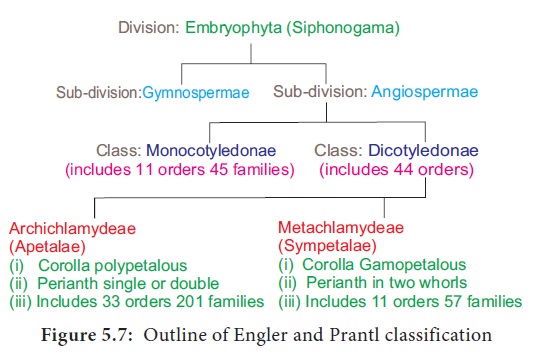Chapter: 11th Botany : Chapter 5 : Taxonomy and Systematic Botany
Phylogenetic system of classification - Taxonomy
Phylogenetic system of classification
The publication of the Origin of Species (1859)
by Charles Darwin has given stimulus
for the emergence of phylogenetic system of classification.
I Adolph Engler and Karl A Prantl system of classification
One of the earliest phylogenetic system of
classification of the entire plant Kingdom was jointly proposed by two German
botanists Adolph Engler ( 1844 -
1930) and Karl A Prantl (1849 -
1893). They published their
classification in a monumental work “Die Naturelichen Pflanzen Familien”
in 23 volumes (1887- 1915)
In this system of classification the plant kingdom
was divided into 13 divisions.

The first 11 divisions are Thallophytes, twelfth division is Embryophyta Asiphonogama (plants with
embryos but no pollen tubes; Bryophytes and Pteridophytes) and the thirteenth
division is Embryophyta Siphonogama (plants with embryos and pollen tubes) which includes seed
plants.
II Arthur Cronquist system of classification
Arthur Cronquist (1919 - 1992) an eminent American taxonomist proposed phylogenetic classification of flowering plants based on a wide range of taxonomic characters including anatomical and phytochemical characters of phylogenetic importance.

He has presented his classification in
1968 in his book titled “The evolution
and classification of flowering
plants.” His classification is
broadly based on the Principles of phylogeny that finds acceptance with major
contemporary authors.

Cronquist classified the angiosperms into two main
classes Magnoliopsida (=dicotyledons)
and Liliopsida

There are 6 subclasses, 64 orders, 320 families and about 165,000 species in Magnoliopsida, whereas in Liliopsida there are 5 sub classes, 19 orders, 66 families and about 50,000 species.
Cronquist system of classification also could not
persist for a long time because, the system is not very useful for
identification and cannot be adopted in herbaria due to its high phylogenetic
nature.
Related Topics